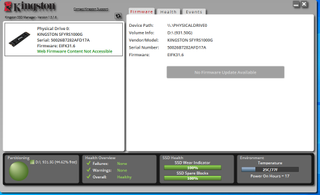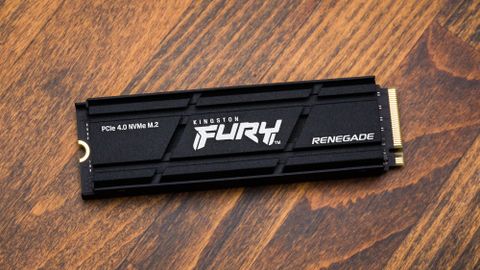Tom's Hardware Verdict
The 2TB Fury Renegade is a competent, high-end PCIe 4.0 SSD. The inclusion of a heatsink adds a bit of value to an otherwise proven formula. However, the hardware is beginning to show its age and this drive will have to be priced competitively to stand out.
Pros
- +
Mature hardware
- +
Heatsink included
Cons
- -
Underwhelming all-around performance
- -
Weak power efficiency
Why you can trust Tom's Hardware
January 9, 2023 Update: We've added new testing for the 2TB Kingston Fury Renegade SSD on page 2.
Original Review published March 14, 2022:
Kingston already has one of the fastest SSDs available on the market, but now the company is expanding its high-performance portfolio with the less expensive Fury Renegade that serves up similar performance but has more write endurance. The extra endurance does come with a tradeoff of slightly less storage capacity, though.
Thanks to its speedy Phison E18 controller and PCIe Gen 4 NVMe interface, Kingston’s KC3000 is a performance leader that’s rated for 7 GBps sequential reads and 6 GBps writes. When we tested and reviewed the KC3000 in late 2021, we were impressed enough to give it an Editor’s Choice award and place it on our list of best SSDs.
The Kingston Fury Renegade promises a few improvements over its sibling while, at $164 for 1TB, it is currently a few dollars cheaper. The Renegade delivers up to 7.3 GBps of bandwidth, a 300 MBps increase, and up to 1 million IOPS over the PCIe 4.0 interface. It touts endurance of 1 petabyte-written-per-TB versus 800 terabytes-written-per-TB for the KC3000 (though both have 5-year warranties). Another key difference between these two very similar drives is that the Fury Renegade is marketed as a gaming SSD and touted as Playstation 5 Ready (though it lacks a heatsink).
A “gaming” SSD does not necessarily offer anything special versus a typical consumer drive. There may certainly be differences -- as there are between the KC3000 and Fury Renegade -- but the impact for a general user is typically small, if not negligible. Overall, we found the Fury Renegade had very similar performance to the KC3000 in our tests, making it one of the fastest PCIe Gen 4 SSDs around.
Specifications of Kingston Fury Renegade
| Product | 500GB | 1TB | 2TB | 4TB |
|---|---|---|---|---|
| Pricing | $102.99 | $164.99 | $359.99 | $1,027.93 |
| Capacity (User / Raw) | 500GB / 512GB | 1000GB / 1024GB | 2000GB / 2048GB | 4000GB / 4096GB |
| Form Factor | M.2 2280 | M.2 2280 | M.2 2280 | M.2 2280 |
| Interface / Protocol | PCIe 4.0 x4 / NVMe 1.4 | PCIe 4.0 x4 / NVMe 1.4 | PCIe 4.0 x4 / NVMe 1.4 | PCIe 4.0 x4 / NVMe 1.4 |
| Controller | Phison PS5018-E18 | Phison PS5018-E18 | Phison PS5018-E18 | Phison PS5018-E18 |
| DRAM | DDR4 | DDR4 | DDR4 | DDR4 |
| Memory | Micron 176L TLC | Micron 176L TLC | Micron 176L TLC | Micron 176L TLC |
| Sequential Read | 7,300 MBps | 7,300 MBps | 7,300 MBps | 7,300 MBps |
| Sequential Write | 3,900 MBps | 6,000 MBps | 7,000 MBps | 7,000 MBps |
| Random Read | 450,000 IOPS | 900,000 IOPS | 1,000,000 IOPS | 1,000,000 IOPS |
| Random Write | 900,000 IOPS | 1,000,000 IOPS | 1,000,000 IOPS | 1,000,000 IOPS |
| Security | N/A | N/A | N/A | N/A |
| Endurance (TBW) | 500 TB | 1,000 TB | 2,000 TB | 4,000 TB |
| Part Number | SFYRS/500G | SFYRS/1000G | SFYRD/2000G | SFYRD/4000G |
| Warranty | 5-Years | 5-Years | 5-Years | 5-Years |
The Fury Renegade is rated for sequential speeds of up to 7.3/7.0 GBps read/write and up to 1M/1M random read/write IOPS. The drive is available in 500GB, 1TB, 2TB and 4TB capacities. Current pricing puts it at $0.19-$0.27 per gigabyte with the sweet spot being at 1TB. There’s a large premium for the highest capacity which is nothing new for 4TB TLC drives; we most recently recommended the WD Red SN700 if you’re strictly looking for TLC capacity.
It’s worth noting again that the Fury Renegade is rated for higher peak sequential read performance than the KC3000, although this does not necessarily translate to a real-world advantage. Additionally, the Fury Renegade has more over-provisioning (OP) - for example, with 500GB of capacity versus the KC3000’s 512GB - which could have some impact. More OP tends to improve write performance and device endurance by ensuring more blocks are free or available for writing.
Write performance is increased as more free blocks translates to the controller being better prepared for writes, especially random ones. Endurance is improved through a reduction in write amplification as blocks have more freedom when being consolidated which also indirectly assists with wear-leveling. We’ll see what impact, if any, this has during testing, although for consumer drives it tends to be insignificant.
Software and Accessories of Kingston Fury Renegade

The Fury Renegade works with Kingston’s SSD Manager app. This “SSD Toolbox” gives basic information about the drive, including the serial and firmware revision as well as usage and health statistics. Although this is unnecessary for many users, it’s nice to have the option, especially as firmware updates have proven more useful as drives have become more advanced. Sometimes improvements or fixes to SLC caching are necessary, for example.
A Closer Look at Kingston Fury Renegade



The Fury Renegade comes in the common M.2 2280 form factor, with a graphene aluminum heat spreader and is single-sided at the 1TB capacity. The heat spreader is stylized but will not do a lot of heavy lifting with regards to cooling; on the other hand, it does mean it will fit in laptops, consoles, and certain motherboards.
The drive sports a controller, two DRAM packages, and two NAND packages along with Phison’s typical PMIC. The back label shows pertinent information such as model, serial, and factory firmware revision plus QR code. We noted this also in our KC3000 review.

The Phison E18 controller is not new to our testbed and is one of the top PCIe 4.0 competitors on the market. The Fury Renegade also has the double-DRAM layout that Kingston uses on multiple products, in this case sporting two 512GB modules for a total of 1TB. These are in the 256M x 16b configuration and using two modules like this has some advantages: this type of DRAM in this layout is potentially cheaper while being more flexible, especially if the board is utilized for multiple models and capacities. The standard 1GB of DRAM per 1TB of NAND applies here, more than enough for consumer usage but nice to see in the age of manufacturer skimping.

The 1TB Fury Renegade sports two 512GB NAND packages which, for interleaving purposes, are in an 8DP configuration. That is, each package has eight 512Gb (64GB) dies, enough for two per channel for the 8-channel Phison E18. Peak performance would come with four dies per channel. This flash is Micron’s 176-layer TLC as seen on the KC3000 and also many other products. Most manufacturers have opted to create a new model for the E18 when paired with this flash versus Micron’s older 96-layer B27B TLC. Both types of flash are four-plane and nominally come with 512Gb dies which does mean performance is quite good at 1TB.
Micron’s 176-layer flash, or B47R, uses a new architecture which promises improvements in performance and endurance. Other flash manufacturers such asSK hynix, have competing 176-layer generation flash on the way. However, the majority of flash displayed during this year’s ISSCC event was of the QLC variety, underlining the fact that 4-bit flash is destined to grab a larger market share in the near future. Nevertheless, 3-bit TLC remains the flash of choice for performance, not least because you can get more interleaving per capacity with less-dense dies.
MORE: Best SSDs
MORE: Best External SSDs and Hard Drives
MORE: How We Test HDDs And SSDs
MORE: All SSD Content

Shane Downing is a Freelance Reviewer for Tom’s Hardware US, covering consumer storage hardware.
